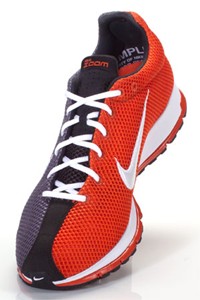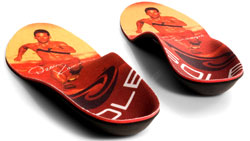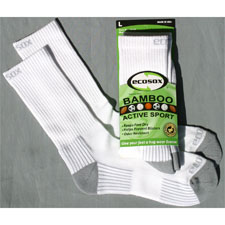|
Running Shoes
Author:
Stan Reents, PharmD
Original Posting:
05/06/2007 11:09 AM
Last Revision: 12/10/2018 05:56 AM
 According to Runner's World magazine, your feet strike the ground 43,200 times during a 4-hr marathon. In other words, good running shoes are important! According to Runner's World magazine, your feet strike the ground 43,200 times during a 4-hr marathon. In other words, good running shoes are important!
Running shoes have come a long way since Nike marketed the Cortez in 1972. Athletic shoes, along with other apparel, have made Nike the largest sports and fitness company in the world. Other popular brands of running shoes include Adidas, Altra, Asics, Brooks, Mizuno, New Balance, Puma, Reebok, Saucony, and many others.
Considering the attention on obesity, and the health benefits attributed to walking, literally every person on earth could be a potential running shoe customer....even if they never actually use them for running. A good pair of shoes is important to prevent injuries. Over the past several decades, running shoes have evolved to become a very sophisticated orthopedic device. As a result, running shoes are not cheap, so you should have an idea of what to look for when shopping.
RUNNING SHOE CONSTRUCTION
In order to buy the right running shoe, you need to be familiar with its various components.
The basic parts of a running shoe include the upper, the sole, and the midsole. Also, there is the tongue, the toe box, the heel cup (more properly known as the heel "counter"), and the laces.
• Outsole: This is the bottom of the shoe. These days, there is as much styling on the sole of some shoes as there is on the upper.
• Inner Sole: No, we're not talking about your deep psyche, here. The inner sole is what you see if you look inside the shoe.
• Midsole: Between the inner and outer soles is yet another layer: the midsole. You can’t see it, but it is one of the most important parts of the shoe. It is this part that gives support to your arch. It can wear-out, too. If the mid-sole is not doing its job, you may need new shoes, even if the inner and outer soles don't appear to be worn out.
• Upper: The upper is the part of the shoe that covers the foot. It is the "stylish" part of the shoe, often made of mesh, and is the part that contains the colorful design and the manufacturer’s name and/or logo.
• Shape/Last: Turn the shoe over and look at the sole. The outline of the sole is called the "last." There are three types of lasts: straight, slightly curved, and curved. If the medial side (ie., the side of the shoe that faces the inside) of the shoe is relatively straight (ie., from toe to heel), it will offer more support. If the medial side of the shoe has a very noticeable curve, it will provide more mobility during each step.
• Construction/Last: There are also three construction options: board lasting, slip lasting, and combination lasting. Board lasting shoes have the greatest stability; slip lasting shoes provide more comfort and flexibility. Combination lasting is a compromise. Combination lasted shoes are slip lasted in the forefoot for flexibility and comfort, but have a board in the rearfoot for stability.
To determine the type of construction, remove the sock liner and look underneath. What you see determines the type of construction/last:
- Board lasting: a fiber board runs from the heel to the forefoot
- Combination lasting: a board extends half-way down the shoe with stitching the rest of the way
- Slip lasting: No board at all
Next, let's discuss the anatomy of the foot, since that is the most important factor to consider when buying running shoes.
WHAT KIND OF FOOT DO YOU HAVE?
If you're planning to purchase new running shoes, and are not familiar with what to look for, the first thing you need to do is assess your foot. Besides length and width, one of the key elements you need to know is how your feet interact with the ground as you run or walk. You may have heard people say they are "flat-footed" or that they have "high arches." The proper term for flat-footed is "overpronator" and the proper term for high arches is "under-pronator" or "supinator."
To determine which category you are, moisten the bottom of your bare foot with water and then step on a flattened brown paper grocery bag. This will produce a silhouette of your foot. If you see almost all of the sole of your foot (ie., from the ball of the foot to the heel and from the inside to the outside), you have a relatively flat foot (overpronator).
If, however, the imprint made by the ball of your foot and your heel appear as two separate tear-drop shapes, then you have a high arch (supinator). If you see only the outer half of your arch in the imprint, then you are neutral.
HOW THE FOOT MOVES
During normal walking and running, the outside of the heel strikes the ground first. At this moment, the foot is in what is called a "supinated" position.
The foot then rolls inward and flattens out. This is called pronation. The foot should then supinate again by rolling through the ball. Some amount of pronation and supination is needed for normal function, but excessive amounts increase the risk for injury.
Several biomechanical problems can interfere with these normal motions. The right type of running shoe can help. However, an inappropriate running shoe can actually interfere with normal foot movement.
The amount of excessive pronation or supination present will determine if you need a running shoe that emphasizes one of two features: motion-control vs. cushioning.
Excessive pronation is the most common cause of running injury. A pronated foot rolls inward at the ankle, the midfoot bulges inward and the longitudinal arch flattens. Those who over-pronate generally have very flexible and unstable feet; these runners need shoes with a lot of motion control. A motion control shoe provides a high level of support. This is accomplished with: a firmer anti-pronation post on the inside of the midsole; a firm or dual density midsole; and a firm heel cup.
A supinated foot has a high arch and rolls outward at the ankle. This type of foot geometry tends to be more rigid and is inefficient at absorbing shock. These runners will need running shoes with a lot of cushioning. The trade-off is that cushioned shoes offer less motion control.
MATCHING THE RIGHT SHOE STYLE FOR YOUR FOOT
Don’t buy a running shoe based only on style. A running shoe, even if you are using it only for walking, needs to fit properly and give you proper support. But, considering that there are hundreds of styles of running shoes, how do you choose the running shoe that is right for you?
My personal opinion regarding running shoes is to focus on quality and not worry about how much the shoes cost. Your feet and legs take a tremendous beating during distance running, so, this is not the gear to save money on. Some have estimated that your foot absorbs forces equivalent to 2.5-3.0 times your body weight each time it strikes the ground while running. If a better quality shoe costs $20-30 more, then, I say, go for it. Chances are, you won't regret it.
SHOES FOR OVER-PRONATORS (FLAT FEET)
• Shape (last): Should be as straight as possible without being uncomfortable. Turn the shoe over and look at the outline of the sole. The outside curve (lateral side) of the sole is not as important as the inside curve (medial side). In general, there will be a slight curve on the inside even in a shoe with a straight last.
• Construction: Optimum design is "board lasted." "Combination lasted" would be your second choice.
• Midsole: The midsole should be firm. A contoured midsole is optimal.
• Heel Cup: The heel cup (counter) should be firm with a hard plastic ring around the bottom. It should be vertical; any inward slant may allow excessive pronation.
• Test: Roll your ankles in; make sure there is a lot of resistance. This is what will prevent pronation. Make certain the shoes fit comfortably.
SHOES FOR OVER-SUPINATORS (HIGH ARCHES)
• Shape (last): The inside (medial) margin of the sole should be as curved as it can be, while the outside margin should be as straight as possible. A noticeable curve on the medial side of the sole encourages pronation which is what people with high arches need. Make sure the outside margin of the sole is straight or semi-straight to help prevent the foot from rolling out.
• Construction: The construction last should be "slip lasted." Combination lasting would be a second choice.
• Midsole: The midsole should be only mildly firm. Cushioning helps with shock absorption.
• Heel Cup: The heel cup (counter) should be firm with a hard plastic ring around the bottom. The heel cup should be vertical; any outward slant may allow supination.
• Test: Roll your ankles out; make sure there is a lot of resistance. This is what will prevent supination. Make certain the shoes fit comfortably. They should feel highly cushioned.
SHOES FOR NEUTRAL FEET
• Construction: A combination last will give the best stability and flexibility.
• Outsole: The outsole should be flexible.
• Midsole: The midsole should be moderately firm.
• Heel Cup: The heel cup (counter) should be firm with a hard plastic ring around the bottom.

INSERTS
Another way to improve the way your running shoes fit and feel is to use shoe inserts. We think these Signature DK Response shoe inserts by SOLE are pretty cool. You simply warm them in the oven, insert them into your shoes, and put them on. The inserts will mold themselves to the exact shape of your feet. If you don't want to heat them up, the inserts will adapt to your feet after several days of wearing them.
SOCKS
And, of course, the type of socks you wear will also affect how your shoes fit, and, how well your feet endure long runs or hikes.
For a long time, cotton has been the main fiber used in athletic socks. However, synthetics like polyester and even bamboo fibers are now commonly used in athletic socks. For example, Endurer socks and Max 1.0 compression socks from Altra Running utilize polyester to achieve moisture wicking.
For some really comfortable athletic socks, consider the EcoSox which is 80% bamboo. I've been wearing these socks since the summer of 2014 and I have to say they're the most comfortable socks I've ever worn. You can get them at Amazon, but, if you'd like to support someone who is a fan of AthleteInMe.com®, buy them from Ginny at www.BestBambooSocks.com in Phoenix.
COMPUTERIZED SHOES
The January 2005 issue of Runner's World magazine contains a story describing the first computerized running shoe: "Adidas-1". According to Adidas, runners, regardless of their weight or foot anatomy, prefer a similar amount of cushioning (35-40% of heel compression). Obviously, no single shoe design can deliver this level of consistency. So, Adidas created a shoe with a built-in computer chip. A magnetic sensor in the heel takes up to 1000 readings per second.
Runner's World magazine tested the shoe in their shoe lab and found that it did deliver on its promise. If runners want more or less cushioning, the shoe can be adjusted with 2 buttons on the side. This technology does have a downside: the shoe is pretty heavy (15.3 ounces for men's size 9) and costs $250.
BANNED SHOES
"Oh come on now!", you must be thinking. "Banned shoes???" Yes, it's true. One company, Spira (formerly: Shoespring), makes a shoe with a springboard in the mid-sole. The shoe is so effective at returning energy back into the stride that USA Track and Field banned it from sanctioned races. But if you're a walker, this type of shoe might appeal to you. For those who are interested, their web site is: www.Spira.com.
QUESTIONS
Q: How often should I replace my running shoes?
ANSWER: If you run regularly, you should replace your running shoes several times per year. Most people don't do that. Keep in mind that the support a shoe provides will wane long before the tread on the bottom is worn. The web site ePodiatry.com recommends replacing running shoes every 1000-km. That works out to one hundred 10-km races or 23 marathons...not counting your training and walking miles. If you run 30-km per week, you would be replacing your shoes every 8 months or so. If you are really determined to keep track of the mileage you put on your running shoes, check out the Shoe Tracker feature on Fitness Journal's web site (www.FitnessJournal.com).
SUMMARY
If you've never purchased running shoes before, here are some tips:
• When trying on new running shoes, wear the same socks, or, the same thickness of socks, you will be wearing when you run.
• Measure both feet (most people have one foot that is larger than the other) and make sure the fit on the larger foot is optimum. You can adjust the fit on the smaller foot with socks or inserts. Remember that your feet swell as the day progresses. Make note of this when buying new shoes.
• Check for adequate length by determining if there is a small space between the end of the longest toe and the end of the shoe.
• The toe box should allow the toes to move, but the foot should not slide around inside the shoe.
• The heel cup should fit snugly; the heel should not feel that it is slipping or rubbing.
• If you use orthotics, try on the shoes with them in. Also, make sure the shoes you buy have insoles that can be removed so you can modify or replace them with orthotics.
• Running shoes should not require a lengthy break-in period; they should feel good the first day you wear them.
FOR MORE INFORMATION
When you need to find a new pair of running shoes, you can begin by looking up details on specific brands in our FITNESS GEAR section.
• Details and Reviews of Running Shoes:
• CompetitiveRunner.com. This site offers ratings and brief descriptions of running shoes.
• www.ePodiatry.com provides a list of recommended brands of running shoes for the different types of foot anatomy, however, it is not clear when this list was last updated.
• www.RoadRunnerSports.com provides fairly detailed information on running shoes.
Runner’s World magazine routinely publishes evaluations of running shoes. Accompanying the reviews are lab tests that rate each brand for flexibility, cushioning, and responsiveness. Runner's World uses the Orthopaedic Biomechanics Lab at Michigan State University to obtain their technical information. They also utilize volunteer testers for the subjective impressions. Shoe reviews are published several times per year in the magazine: (www.RunnersWorld.com).
• Interactive Web Tools To Help You Find The Right Running Shoes:
If you'd like some help picking out the right running shoe, consider Road Runner Sports' "Shoe Dog" tool. This web tool obtains details about your body size, your foot anatomy, and your running style and then presents you with suggestions.
Readers may also be interested in these topics:
EXPERT HEALTH and FITNESS COACHING
Stan Reents, PharmD, is available to speak on a variety of exercise-related topics. (Here is a downloadable recording of one of his Health Talks.) He also provides a one-on-one Health Coaching Service. Contact him through the Contact Us page.
ABOUT THE AUTHOR

Stan Reents, PharmD, is a former healthcare professional. He is a member of the American College of Lifestyle Medicine (ACLM) and a member of the American College of Sports Medicine (ACSM). In the past, he has been certified as a Health Fitness Specialist by ACSM, as a Certified Health Coach by ACE, as a Personal Trainer by ACE, and as a tennis coach by USTA. He is the author of Sport and Exercise Pharmacology (published by Human Kinetics) and has written for Runner's World magazine, Senior Softball USA, Training and Conditioning and other fitness publications.
DISCLOSURE: Neither the author, nor AthleteInMe, LLC, has any financial relationship with any of the companies or products discussed in this review.
Browse By Topic:
exercise equipment, fitness gear, running, running shoes, treadmills, triathlon, walking
Copyright ©2025 AthleteInMe,
LLC. All rights reserved.
|